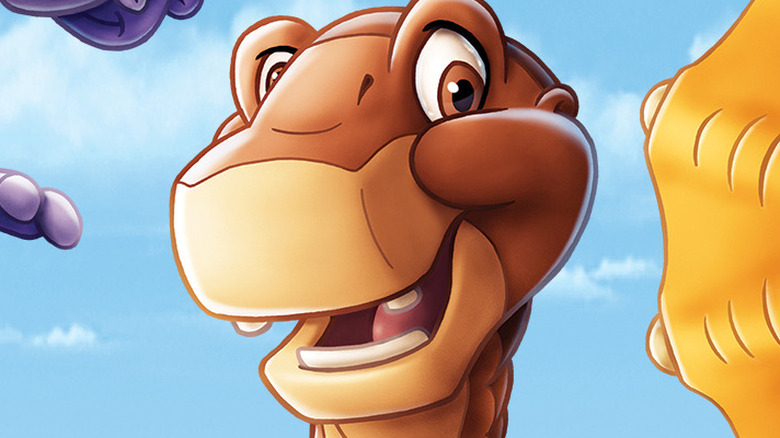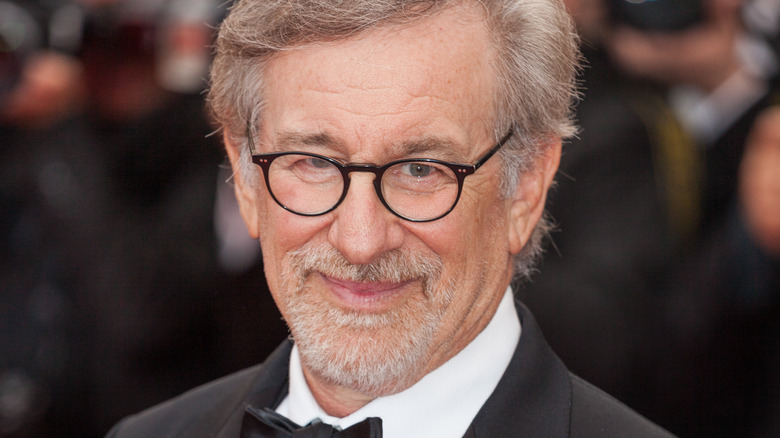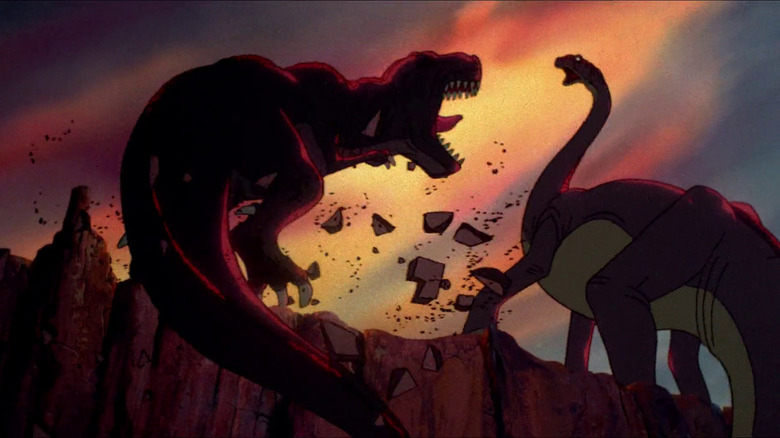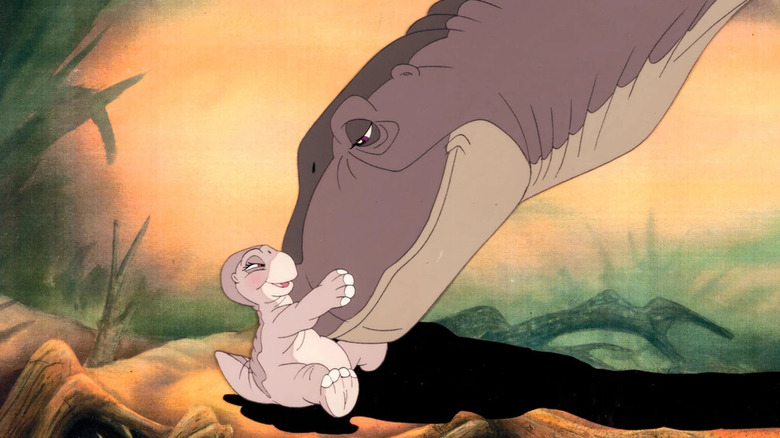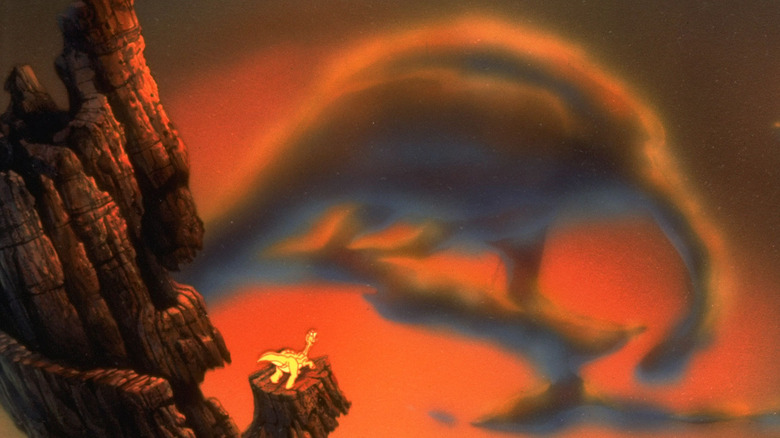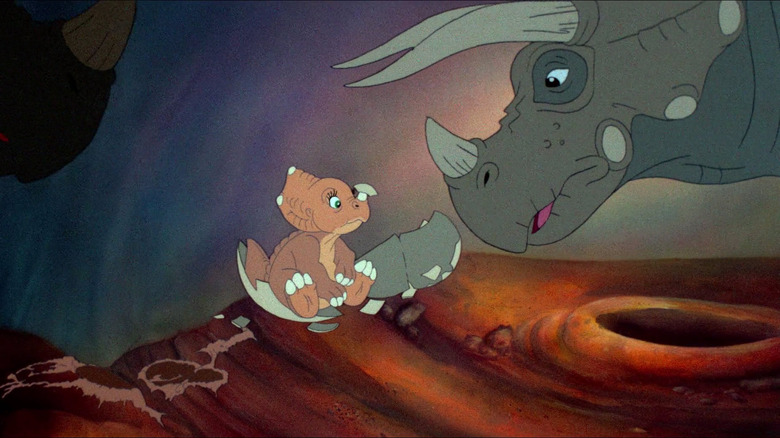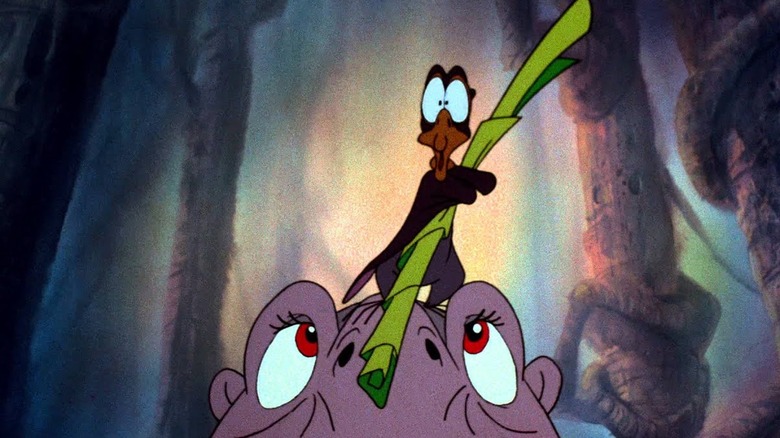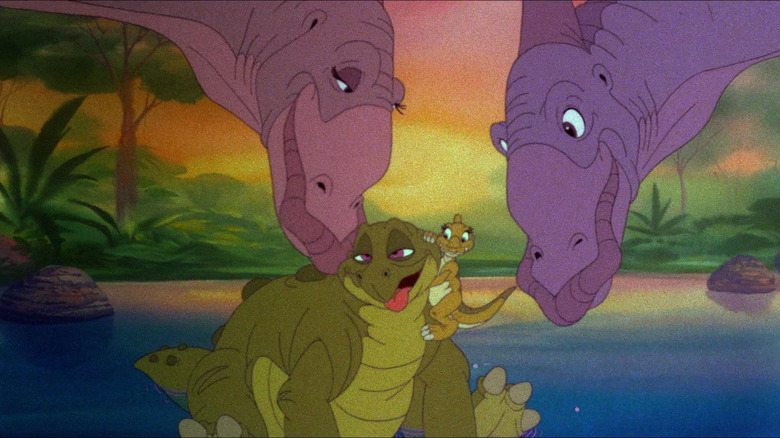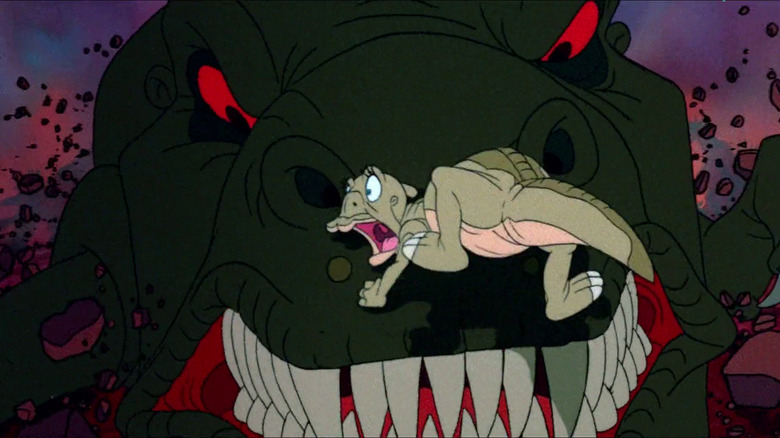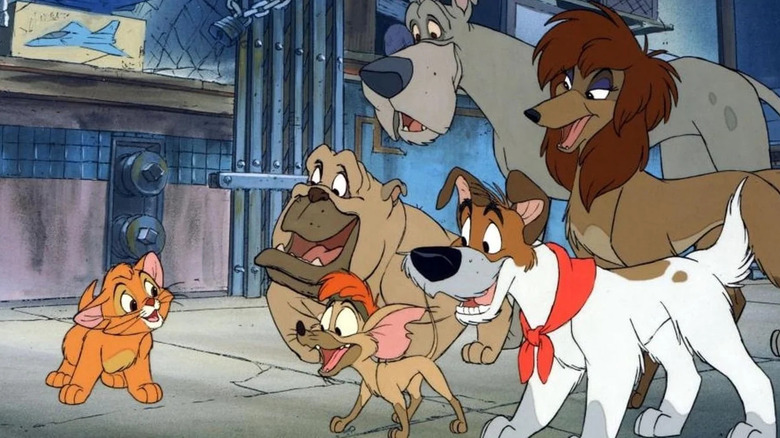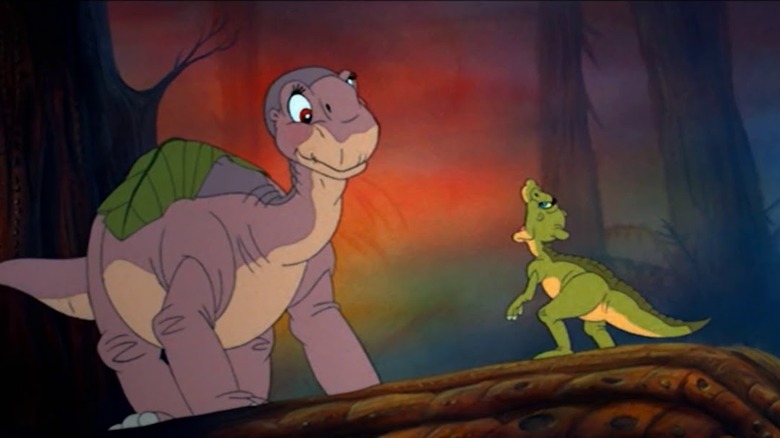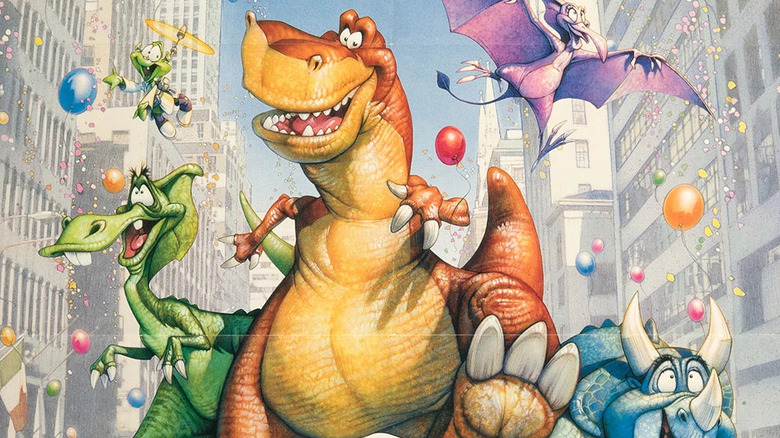The Land Before Time Has An Animated History
While not as popular as some of the big-ticket movies from major studios like Disney and Dreamworks, "The Land Before Time" is still a solid member of the B-team of childhood animated classics. Even if it's not as overwhelmingly successful as the likes of "Shrek" and "The Lion King," none of its competitors can match the mind-boggling number of sequels and spinoffs "The Land Before Time" spawned: 13 direct-to-video sequels, 14 video games, and a TV show.
You need a solid foundation for a structure that size, and the original "The Land Before Time" delivers. Kids are bound to lap up anything with cute talking dinosaurs, but it's not just kids' stuff. Dead parents are practically a cliché in animated movies, but few deal with the resultant grief as thoughtfully as "The Land Before Time" does. The production design reflects that underlying darkness, starting with the stark beauty of the threatening, shadowy world of the dinosaurs' last days, mixed with psychedelic colors to create a film that looks like few others.
None of this wouldn't have been possible without a dream team of behind-the-scenes talent — producers Steven Spielberg, George Lucas, and Kathleen Kennedy, along with director Don Bluth, an ex-Disney man coming hot off the back-to-back successes of "The Secret of NIMH," "An American Tail," and the "Dragon's Lair" games. As for how these artists brought their vision to the screen, that's at least as interesting a story as Littlefoot and friends' journey to the Great Valley. Here are the highlights.
The Land Before Time started as a pitch from Steven Spielberg
A Steven Spielberg producing credit isn't as special as it sounds: He's rubber-stamped his name on nearly 200 movies and series. But the great director took a much more hands-on approach to "The Land Before Time." In fact, without him, there would be no "Land Before Time." John Cawley's "The Animated Films of Don Bluth" describes Spielberg playing with the idea of "doing something with dinosaurs" — which he'd eventually do himself in "Jurassic Park" — during the production of "An American Tail."
Disney often gets credit for the remarkable revitalization of American cartoons in the '90s, but Spielberg deserves at least as much. Along with his collaboration with Bluth, Spielberg produced "Who Framed Roger Rabbit" that same year, a tribute to the classic animated shorts that inspired a hundred other revival attempts and raised the bar for detailed, expressive animation.
Spielberg wanted "The Land Before Time" to do for the magic of the early Disney features what "Roger Rabbit" did for the slapstick of the Warners Bros. and MGM shorts. He described it as "Bambi with dinosaurs" — apt not just for the dead-mother plot, but also for the relatively realistic approach to its animal heroes and their harsh environment — mixed with the prehistoric grandeur of the "Rite of Spring" section in "Fantasia."
The Land Before Time was originally dialogue-free
One part of Spielberg's pitch is especially intriguing, but sadly never made it to the screen. Possibly inspired by "Fantasia," he wanted "The Land Before Time" to tell its story without a spoken word. Unfortunately, this fell by the wayside pretty quickly.
The dream of a silent dinosaur movie lived on, though. According to Cinefantastique, the project that wound up becoming Disney's "Dinosaur" began with an idea from "RoboCop" director Paul Verhoeven and "Jurassic Park" effects artist Phil Tippett, which Tippett described as "a gritty true-life adventure where all the storytelling would be carried on in action and pantomime." He added that Disney would have had to release it on one of their adult-oriented labels like Hollywood Pictures, and it's quickly clear why: "There was a gigantic battle at the end as a comet moves closer and closer to Earth," Tippett explained. "The fight was between the sympathetic Styracosaurus and the antagonist Tyrannosaurus rex, and although the good guy wins, there's nothing to win any more because the comet hits Earth, and all the dinosaurs die."
After Verhoeven and Tippett left, Ralph Zondag, animation director on "The Land Before Time," took over. According to SyFy, Disney then insisted on having a narrator, or a talking mammal, or giving the dinosaurs internal monologues, until "Dinosaur" eventually became just another talking-animal movie.
Littlefoot got his name to duck copyright infringement
It didn't take long for the story team to put together the movie's familiar characters: Petrie, Duckie, and ... Thunderfoot? Yes, Thunderfoot: Jerry Beck's "Animated Movie Guide" reveals Littlefoot originally had a much more intimidating name. That didn't last, though, because the studio discovered a children's book had already claimed the name. Beck may have been referring to "Thunderfeet: Alaska's Dinosaurs and Other Prehistoric Critters," a non-fiction picture book. If that's the case, Littlefoot's name change came down to the wire, since both "Thunderfeet" and "The Land Before Time" came out the same year.
This wasn't the first time Bluth had faced this problem: John Cawley wrote that adapting the novel "Mrs. Frisby and the Rats of NIMH" into "The Secret of NIMH" got Bluth in trouble with Wham-O, owners of the Frisbee trademark. They threatened legal action after the voice-recording process was already done, forcing Bluth to go back and replace every instance of "Frisby" with "Brisby."
It's easy to imagine that Bluth and company wanted to swing as far as possible from their original, legally actionable character name this time: A little foot implies something much lighter and smaller than a thundering one. As for the Southern rock band Little Feat, they seem to have let it slide.
Psychologists consulted on Littlefoot's mother's death
Everyone remembers the death of Bambi's mother. For many young viewers, it was their introduction to the concept of death in general. But in many ways, Don Bluth handles the death of Littlefoot's mother even more sensitively. Bambi's mother dies offscreen and is never mentioned again. Littlefoot stays with his mom through her last breath, and his loss becomes one of his defining character traits.
This is heavy stuff to lay on kids, and Bluth tread carefully. John Cawley describes how the director consulted psychological experts on how best to handle the sequence. Bluth almost cut the plot point entirely before he realized he couldn't show the arc of Littlefoot maturing if his parents were still in the picture. On the psychologists' advice, he added a new character named Rooter to "soften the blow" and teach Littlefoot (and by extension, the children in the audience) about healthy coping mechanisms and the meaning of death. If the scenes of Littlefoot waiting by his mother's side as she dies and consulting her ghost in the clouds remind you of "The Lion King," the scene with Rooter should confirm once and for all that Disney was taking notes: He discusses "the Circle of Life," the central theme of the later movie.
Cera spent half the production as a boy
Cera, the bossy, bratty triceratops, becomes an unwilling participant in the journey of Littlefoot and his friends since she's internalized her herd's lessons not to interact with other species. Eventually, of course, they have to put aside their differences to survive.
For a long time, however, Cera wasn't Cera. She wasn't even a she: According to Jerry Beck, she was a boy named Bambo (yet another "Bambi" reference?). John Cawley elaborates further in his book on what a last-minute decision Cera's gender was. Where most American animated movies put all the voices in place before animation begins to make sure the lip-synching comes out right, the casting for "The Land Before Time" was more chaotic. Cera's animation was already well underway when Bluth decided to go with a female voice. She wasn't even the only one: Cawley describes multiple characters who were cast, recorded, recast, and rerecorded before the voice talent finally fell into place.
Spielberg's son chose Petrie's voice
"The Land Before Time" has millions of fans, but its director isn't one of them. John Cawley's book describes Don Bluth fighting to get the darkness and complexity that had made "The Secret of NIMH" (and "Bambi" and "Fantasia" for that matter) such an enduring masterpiece into "Land," which put him "at odds with the other parties' desires to produce 'a cute movie about dinosaur kids,' as one executive called the project." "The Animated Movie Guide" quotes an interview with Bluth by the Chicago Sun-Times that boils it down to the simplest terms: "I didn't have a free enough hand."
That's something every filmmaker — and any artist in a collaborative medium — has to deal with eventually. But it's not hard to understand Bluth's frustration when decisions aren't just being made for you by your bosses, but by their children too. If you're wondering why all the dinosaur kids sound like real kids except for Petrie, here's your answer: Cawley writes that Steven Spielberg's son Max suggested casting "Digit's voice" as the little pterosaur. In adult terms, that means Will Ryan, who played Digit the cockroach accountant in "An American Tail," along with over 100 other roles spanning 40 years, including Dale in "Chip 'n' Dale Rescue Rangers," the Duck Brothers in "Courage the Cowardly Dog," and multiple G.I. Joes.
Bluth based Spike on his dog
Some characters in "The Land Before Time" were more personal to Don Bluth. Spike the "spike-tail" is the only one of the main characters besides the Sharptooth not to talk. In the story, it's because he's just a hatchling. But outside of the narrative, it makes him the least anthropomorphic and most realistically animalistic of the dino caravan.
There's another reason for that: Spike is based on a real animal, Don Bluth's chowhound Cubby. Along with revealing this little tidbit, "The Animated Movie Guide" cites Spike as Bluth's favorite character (no wonder) and documents his description of both dog and dinosaur: "a pure soul, simple, accommodating, and easy to please." Once you know Spike's canine inspiration, it's easy to see it in other ways, like his ravenous appetite, barking noises, and long tongue. That may be why he's so popular with kids; if they love anything more than dogs, it's dinosaurs, so who wouldn't want to have a dinosaur that's also a dog?
Spielberg and Lucas cut a million dollars' worth of footage
One of the oddest things about "The Land Before Time" is its running time: one hour and 10 minutes, barely feature-length even for an animated children's film. Most movies that long are made on the quick and cheap, but the lush animation and effects obviously don't place "The Land Before Time" in that category. In fact, it's just the opposite: The producers took a major financial loss to cut the movie down to that length.
Don Bluth's career was based on the premise that kids can handle more than adults give them credit for. You can see this approach in the horrific imagery and explicit violence in "The Secret of NIMH," the themes of abandonment and antisemitism in "An American Tail," and the vision of hell in "All Dogs Go to Heaven."
Bluth originally planned for "The Land Before Time" to be more of the same. But John Cawley quotes an Animation Magazine article describing how Spielberg and Lucas balked at his vision. They cut 10 minutes of animated, inked, and painted footage, which Cawley estimates cost a million dollars, because they "felt that it was too frightening and could even cause some psychological damage in very young children." Some 19 scenes were scrapped altogether, with a special focus on moments of the characters in mortal danger. Scribbles to Screen's breakdown fills in the gaps with storyboards and trailers to suggest what the deleted scenes might have looked like.
The release date pitted Don Bluth against his old Disney bosses
Don Bluth had been a veteran Disney animator since the '50s, until he got frustrated trying to restore the fading studio to its past glory and started his own. He lived up to his ambition a little too well: The success of his first two films and his partnership with Universal and Spielberg's Amblin studio made him one of Disney's biggest competitors. And Disney, especially now that new bosses Michael Eisner and Jeffrey Katzenberg wanted it back on top again, wasn't kind to competitors.
Opening weekend saw Bluth and Disney competing in the most direct way possible, with "The Land Before Time" and Disney's "Oliver and Company" opening the same day in November 1988. Bluth won the first round: the opening gross for "The Land Before Time" (via Box Office Mojo) almost doubled the take for "Oliver." According to John Cawley, "The Land Before Time" brought in more per theater that weekend than "Oliver" did worldwide.
But you don't get to be the biggest animation studio in the world by giving up easily, and Disney refused to admit defeat. While Universal moved on to other films, Disney kept pushing "Oliver." There were even rumors that Eisner planned to keep "Oliver" in theaters through the following summer if that meant he could top the combined totals for "Land" and "An American Tail." He didn't get that far, but persistence paid off: "Oliver" managed to squeak out a $5 million lead over "Time" domestically when the final tallies came in, although the latter eventually made more worldwide.
Ducky's voice has her catchphrase on her headstone
Content note: This slide contains descriptions of child abuse, domestic abuse, and murder.
One of the breakout stars of "The Land Before Time" was Judith Barsi, who plays the appropriately named "big mouth" Duckie, with her distinctive habit of repeating words ("Yep! Yep! Yep!" "Nope! Nope! Nope!"). Bluth was impressed enough with Barsi to give her a bigger role in his next project, "All Dogs Go to Heaven."
But fame couldn't protect Barsi from her abusive father. If anything, it made a bad situation worse: the Los Angeles Times reported that he said goodbye to her as she left home to film "Jaws: The Revenge" by brandishing a knife and threatening to kill her if she didn't come back. He followed up on that threat before Barsi could hear herself onscreen in either "Time" or "Dogs." In July 1988, he killed his daughter, his wife, and himself. Barsi was only 10 years old.
There's no happy ending to a crime that horrific, but Barsi's surviving family at least managed to put together a fitting tribute to her tragically short life. She's buried next to her mother at Forest Lawn Cemetery in Los Angeles, with the epitaph "Yep! Yep! Yep!" It's both a poignant tribute to her too-brief career and an optimistic message in a situation that didn't seem to have any bright side.
If you or someone you know may be the victim of child abuse, please contact the Childhelp National Child Abuse Hotline at 1-800-4-A-Child (1-800-422-4453) or contact their live chat services.
Spielberg hired the co-director for another dinosaur cartoon
After "The Land Before Time," Don Bluth split with Steven Spielberg for a new partnership with Goldcrest International. Spielberg didn't lose interest in animation, though: He continued promoting the medium's '90s resurgence by producing the classic "Tiny Toon Adventures" and "Animaniacs" series. Some of the infrastructure from the Bluth-Spielberg collaboration evolved into a new studio, Amblimation, even though it only produced three films. One of them was "We're Back!: A Dinosaur's Story." SyFy Wire described it as an alternative for kids who were too young for the intensity of Spielberg's "Jurassic Park," with the tagline, "A Dinosaur Adventure for the Whole Family!"
To oversee the project, Spielberg remembered the animation director on "The Land Before Time," Ralph Zondag. For the most part, Zondag delivered on the assignment: "We're Back!" features a cast of literally defanged saurians, thanks to Captain Neweyes' "Brain Grain Cereal." This allows the inventor (voiced by legendary news anchor Walter Cronkite) to bring them to the present and fulfill kids' wishes to meet real dinosaurs.
But Zondag had obviously picked up some of Bluth's dark streak. The dinosaurs meet some kids who've run away from home to join the circus, where they meet Neweyes' estranged brother, Professor Screweyes (Kenneth Mars). The Professor's Eccentric Circus is just about as scary as anything in "Jurassic Park," and he gets a sendoff — it's too surreal to accurately call it a "death scene" — as haunting as any movie character ever got.
